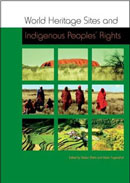

Publicaciones | "Rapa Nui National Park, Cultural World Heritage : The Struggle of the Rapa Nui People for their Ancestral Territory and Heritage, for Environmental Protection, and for Cultural Integrity"
"Rapa Nui National Park, Cultural World Heritage : The Struggle of the Rapa Nui People for their Ancestral Territory and Heritage, for Environmental Protection, and for Cultural Integrity" | - 3 de diciembre de 2014

Leslie Cloud est l’auteure, avec Erity Teave, d’un article intitulé "Rapa Nui National Park, Cultural World Heritage : The Struggle of the Rapa Nui People for their Ancestral Territory and Heritage, for Environmental Protection, and for Cultural Integrity" paru dans l’ouvrage collectif "World Heritage Sites and Indigenous Peoples’ Rights"dirigé par Stefan Disko et Helen Tugendha, IWGIA, Forrest Peoples Programme and Gundjeihmi Aboriginal Corporation, 2014.
Présentation de l’ouvrage
This book includes 20 case studies of World Heritage sites from around the world and relevant background articles. The case studies explore and document, from a human rights perspective, indigenous peoples’ experiences with World Heritage sites and with the processes of the World Heritage Convention. They also identify recurring concerns and systemic shortcomings in the implementation of the Convention, as well as opportunities the Convention may provide for indigenous peoples and the defense and promotion of their human rights.
Of the more than 1,000 areas designated as World Heritage sites under UNESCO’s 1972 World Heritage Convention, a large number are fully or partially located within the traditional territories of indigenous peoples and are of great significance for their livelihoods and their spiritual, social and cultural well-being. World Heritage sites can play a positive role for indigenous peoples by helping them protect their lands and territories, cultures and heritage from development pressures. However, throughout the World Heritage Convention’s history, indigenous peoples have frequently raised concerns about violations of their rights in World Heritage sites. With the adoption of the United Nations Declaration on the Rights of Indigenous Peoples (UNDRIP, 2007), the principles of which UN agencies such as UNESCO are required to promote and apply in their work, there has been increasing attention on the need for improvements in the way the World Heritage Convention is implemented, in order to ensure that the rights of indigenous peoples are respected in World Heritage sites.
This book will serve as a resource for indigenous peoples, as well as World Heritage site managers and UNESCO, and contribute to discussions about what changes or actions are needed to ensure that World Heritage sites can play a consistently positive role for indigenous peoples, in line with the spirit of the UN Declaration for Indigenous Peoples.
The book will also be of interest to academics and practitioners in the fields of cultural heritage, environmental conservation policy and human rights.
Table des matières
La table des matière est disponible au téléchargement ici
Référence
Leslie Cloud & Erity Teave, 2014, "Rapa Nui National Park, Cultural World Heritage : The Struggle of the Rapa Nui People for their Ancestral Territory and Heritage, for Environmental Prot, ection, and for Cultural Integrity" in Stefan Disko & Helen Tugendha (Eds.), World Heritage Sites and Indigenous Peoples’ Rights, IWGIA, Forrest Peoples Programme and Gundjeihmi Aboriginal Corporation.

 Versión imprimir
Versión imprimir